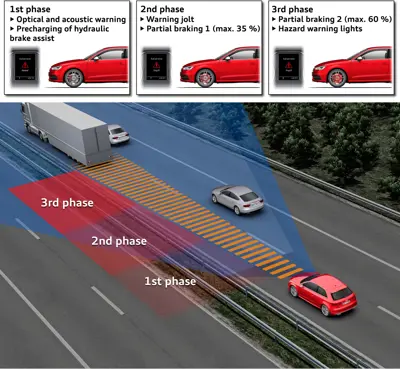- ADAS
- ACC
- ABS
- ALC
- AEB
- AES
- APA
- BSM
- CAS
- DDD
- DMS
- Efficiency Assist
- ESC
- Exit Warning
- FCW
- FCTA
- LCA
- LDW
- LKA
- RCTA
- TSR
Autonomous Emergency Braking
Autonomous Emergency Braking (AEB) is an advanced safety feature in modern vehicles that helps prevent or mitigate collisions by autonomously applying the brakes if the driver fails to react to an impending collision.
Autonomous Emergency Braking (AEB) systems use sensors such as cameras, radar, and lidar to detect potential collisions with vehicles, pedestrians, or obstacles in the vehicle's path. If the system determines that a collision is imminent and the driver has not taken action to avoid it, the system will automatically apply the brakes to either slow down or stop the vehicle before impact.
There are two main types of AEB systems:
Forward Collision Warning (FCW) with Autonomous Emergency Braking: FCW uses sensors to detect the distance and speed of vehicles or obstacles ahead and provides a visual or audible warning to the driver if a potential collision is detected. If the driver fails to respond, the AEB system engages and applies the brakes to prevent or reduce the severity of a collision. Read more about FCW here.
Pedestrian Detection with Autonomous Emergency Braking: This type of AEB system uses sensors to detect pedestrians in the vehicle's path and will apply the brakes autonomously if the driver does not take action to avoid a collision.
AEB can improve road safety by reducing the likelihood and severity of collisions. However, it’s important to note that AEB systems are not a substitute for attentive and safe driving practices, and drivers should always remain focused and alert while behind the wheel.
The European Union (EU) has implemented regulations for AEB systems on new passenger cars and light commercial vehicles as part of the General Safety Regulation (GSR) (EU) 2019/2144. The regulations require that all new vehicles sold in the EU must be equipped with an AEB system as standard equipment.
The EU regulation specifies that the AEB system must meet the following requirements:
- Detect vehicles and pedestrians in the path of the vehicle and operate at speeds up to at least 60 km/h (37 mph).
- Provide a warning to the driver in the event of an imminent collision.
- Apply the brakes autonomously if the driver fails to respond to the warning to prevent or mitigate a collision.
- Operate in various driving conditions, such as urban, rural, and motorway environments.
- Minimize the risk of false alarms or unwanted braking events.
The EU regulation also requires manufacturers to provide a standard set of performance tests to demonstrate the effectiveness of the AEB system.
Overall, these requirements aim to improve vehicle safety on European roads by reducing the likelihood and severity of collisions, especially in situations where the driver may not react quickly enough to avoid a collision.
EURO NCAP performs tests and ratings of these systems:
- AEB Cyclist - Tests of the system against cyclists.
- AEB Pedestrian - Several tests related to pedestrians.
- AEB Motorcyclist - Several tests related to motorcycles.
- AEB Car to Car - Several tests related to cars.
Below, you see the Euro NCAP test of the Tesla Model Y. From 2:30, you see different AEB tests.

